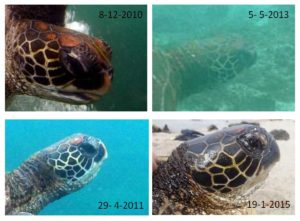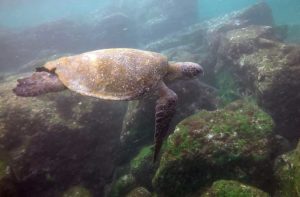Sea turtles are plentiful in the coves and along the beaches of the Galapagos. Unlike the fish ensconced in large schools or cowering in the crevices between rocks, they appear to have little concern for the commotion around them. Even in the sea, they maintain the inscrutable posture of a turtle.
Two species are common in the waters of the Galapagos: green sea turtles (Chelonia mydas), which come in black and yellow morphs, and the more diminutive and much rarer Hawksbill (Eretmochelys imbricata). Green turtles are larger, with rounded shells. The Hawksbills have flatter shells with overlapping plates and a sharp beak. Both are endangered, the Hawksbill critically so.Female sea turtles crawl up the beach to lay eggs that they bury in nests near the vegetation line. Their tracks up and back in the sand resemble those of a small tank. When the turtles hatch they scramble down to the surf and head out to the open sea. Researchers know little about their youthful adventures, but most return a few years later to take up residence in the same coves and shallows as their parents.
As part of our research work we followed the turtles and documented the nature of their habitat. For the most part they spend their time grazing on algae, resting on the deep, sandy bottom or paddling from place to place. Keeping pace with them was not hard. Occasionally, they would dart ahead but often they seemed to float motionless until I caught up, glancing over every so often to see if I was still there.
When they’re flying through the water, they may surface every five minutes or so for a breath of air but they apparently can lay nearly motionless in the water for hours at a time. Their slow, deliberate movements overall may be part of a strategy to maximize their oxygen efficiency.Tagging is a common practice when tracking wildlife, what ecological researchers refer to as “mark and recapture”. They use it to estimate populations and range boundaries. But tags fall off, and the experience can be traumatic for the turtles. Researchers on San Cristobal have begun using a version of facial recognition software as a substitute for tagging. They take photographs of the turtles and are able to identify them later based on the unique “fingerprint” of the spots on their faces. They can only physically capture a limited number of turtles in a day, but they can photograph hundreds. They use not only their own photos but those of other researchers, students, the community and even tourists posting online. While they have only taken photos themselves since 2013, they have tracked some turtles back as far as 2009.

The same sea turtle was visually “captured” in the Galapagos over five years using photos from both researchers and the public.
Among their early findings are that the turtles stay within a fairly narrow range of a few miles and do most of their feeding in shallow waters close to the coast. They retreat to deeper waters primarily to rest. At the same time, there is significant genetic diversity from populations all across the Pacific and as far away as Australia.
Newly hatched turtles are highly vulnerable, but adult turtles have few predators other than large sharks and killer whales. They are more likely to get caught in a fisherman’s net or slashed by a boat’s propeller.

